Taking your first step into the world of photography is always a challenge. Complicated technical terms, dozens of brands offering similar products, and rules to remember while shooting can be difficult to navigate when you are starting out. However, once you get a hold of a DSLR camera, you’ll learn that the learning curve is steeper than expected. But what is the best entry-level DSLR camera?
For years Nikon and Canon have been the most widely known brands on the market. Recently the DSLR landscape seems to have become more diverse, with players such as Sony or Pentax offering cameras that are both powerful and affordable. When looking to buy an entry-level DSLR camera you should, of course, consider its price, but also what you plan to do with it and where you plan to take it.
While my journey in photography began a decade ago with tiny 6-megapixel Nikon D40, over the years I’ve tested a variety of DSLR cameras designed for both beginners and professionals. The technology has certainly improved. Even the cheaper cameras today can produce high-resolution images worth framing and that makes deciding which model to buy even more difficult.
In this article, we will explore the best DSLRs currently available on the market, with models mean to suit every budget and type of photography. Whether you are interested in a lightweight camera to take on your travels or a video-friendly model to step up your vlogging game, there is something for you.
Canon EOS Rebel T100 / 4000D
Best budget entry-level DSLR
 100vw, 1024px”><figcaption>Canon EOS Rebel T100 / 4000D</figcaption></figure>
</div>
<p>It can be a big jump changing from a typical point-and-shoot digital camera or a smartphone to a big DSLR. You may be worried that by not knowing what you’re doing you will end up with bad photos. The Canon EOS Rebel T100 is here to change that. Amazing quality photos combined with HD video capabilities ensure that you’ll be telling powerful stories without effort. The 18-megapixel sensor guarantees great results, while the built-in flash ensures that you aren’t left without light if you go shooting in dark locations. Considering the price of this easy to use DSLR, the low-light performance is impressive. With only 3 frames per second it may not be the fastest camera available, but it is definitely a good pick if you are starting out and don’t want to break the bank.</p>
<p> <strong>Pros:</strong></p>
<ul>
<li>One of the cheapest DSLRs</li>
<li>Simple controls</li>
<li>Fast Shutter speed</li>
</ul>
<h4>Specifications:</h4>
<ul>
<li>Sensor: APS-C</li>
<li>Megapixels: 18MP</li>
<li>Lens mount: Canon EF-S</li>
<li>LCD: 2.7-inch tilting, 230,000 dots</li>
<li>Burst speed: 3fps</li>
<li>Max video resolution: 1080p</li>
<li>Weight: 436 grams</li>
</ul>
<p>Buy on Amazon.</p>
<h2>Nikon D3500</h2>
<p><em>Best lightweight DSLR</em></p>
<div class=)
 100vw, 1000px”><figcaption>Nikon D3500</figcaption></figure>
</div>
<p>If you’re making the switch from a point-and-shoot camera into the world of DSLRs, the Nikon D3500 is the perfect stepping stone. This camera boasts is just as easy to use as a typical point-and-shoot, with a comfortable and compact design that is easy to take along with you to wherever you may be shooting. Leaving on auto mode lets the camera do the work in ensuring you come away with the perfect shot, however, the manual controls are just as easy to use, when you feel like stepping up your game. You don’t have to stop at pictures, as the Nikon D3500 is also capable of taking videos at a smooth 1080/60p. Sharing your photos is a breeze too, as you can download the Snapbridge app to download your photos and post as you shoot. </p>
<p> <strong>Pros</strong> <strong>:</strong></p>
<ul>
<li>Great price</li>
<li>The battery allows taking more than 1500 shots on a single charge</li>
<li>Very light and compact</li>
</ul>
<h4>Specifications:</h4>
<ul>
<li>Sensor: APS-C</li>
<li>Megapixels: 24.2MP</li>
<li>Lens mount: Nikon F</li>
<li>LCD: 3-inch tilting, 921,000 dots</li>
<li>Burst speed: 5fps</li>
<li>Max video resolution: 1080p</li>
<li>Weight: 365 grams</li>
</ul>
<p>Buy on Amazon.</p>
<h2>Pentax KP</h2>
<p><em>Best DSLR for action photography</em></p>
<div class=)
 100vw, 444px”><figcaption>Pentax KP</figcaption></figure>
</div>
<p>If versatility is your aim, make the Pentax KP your game. This camera comes equipped with a large 24-megapixel sensor that will be sure to satisfy even the best of photographers. Sturdy and durable, the Pentax KP can withstand light rainfall and a small drop without any serious damage. After all, accidents happen even to the best of us! This camera is able to perform in whatever situation you put it through, whether that’s taking macro images of a bee settled on top of a flower in your garden, or a beautiful HDR picture of a landscape. The image quality is superb, and the camera is able to perform extremely well in low light, being able to shoot using at ISO of up to 25,600 without skimping on quality.</p>
<p> <strong>Pros:</strong></p>
<ul>
<li>Weather sealed</li>
<li>Fantastic low light performance</li>
<li>Fast and accurate autofocus</li>
</ul>
<h4>Specifications:</h4>
<ul>
<li>Sensor: APS-C</li>
<li>Megapixels: 24MP</li>
<li>Lens mount: Pentax KAF2</li>
<li>LCD: 3-inch tilting, 921,000 dots</li>
<li>Burst speed: 7fps</li>
<li>Max video resolution: 1080p</li>
<li>Weight: 703 grams</li>
</ul>
<p>Buy on Amazon.</p>
<h2>Canon EOS Rebel T7</h2>
<p><em>Best entry-level DSLR under $500</em></p>
<div class=)
 100vw, 868px”><figcaption>Canon EOS Rebel T7</figcaption></figure>
</div>
<p>If you’ve been finding that your iPhone just isn’t cutting it for the kind of photos you want to take anymore, look no further than the Canon EOS Rebel T7. This camera is extremely easy to use, making the switch from a smartphone to DSLR an absolute breeze. The 24.1-megapixel sensor is able to capture realistic colors in all environments, while the improved image processor offers fast performance and grain-free pictures even in low light. Both these specs have greatly improved from the previous T6 model, which featured an 18-megapixel sensor and lower ISO performance. With built-in WiFi connectivity, you can instantly share your photos back to your phone, so your followers won’t have to wait to see your shots. The ability to connect it to your phone, allows you to use your phone as a remote control if you’re taking photos on a tripod or using the self-timer.</p>
<p> <strong>Pros:</strong></p>
<ul>
<li>Great resolution</li>
<li>Wi-Fi and NFC connectivity</li>
<li>High ISO performance compared to previous models</li>
</ul>
<h4>Specifications:</h4>
<ul>
<li>Sensor: APS-C</li>
<li>Megapixels: 24.1MP</li>
<li>Lens mount: Canon EF-S</li>
<li>LCD: 3-inch tilting, 920,000 dots</li>
<li>Burst speed: 3fps</li>
<li>Max video resolution: 1080p</li>
<li>Weight: 475 grams</li>
</ul>
<p>Buy on Amazon.</p>
<h2>Canon EOS Rebel T7i</h2>
<p><em>Best DSLR for beginner vlogger</em></p>
<div class=)
 100vw, 1024px”><figcaption>Canon EOS Rebel T7i</figcaption></figure>
</div>
<p>If you’re looking for a camera that will provide a great beginner experience, with easy to use controls without skimping on quality, the Canon EOS Rebel T7i is exactly what you’re looking for. This camera is quite small compared to other DSLRs in the same price range, making it a really convenient option for traveling around to different locations or taking it with you on holiday. It has a fast and accurate 45-point autofocus system and the controls are easy to find on the body. Once you get the hang of using them, you’ll find shooting in manual mode a breeze. The LCD touchscreen can be flipped and rotated, making the T7i an excellent candidate for vloggers looking to film themselves talking at a high-resolution.</p>
<p><strong>Pros:</strong></p>
<ul>
<li>45-point Autofocus System</li>
<li>Bluetooth, Wi-Fi, and NFC connectivity</li>
<li>Vari-angle Touchscreen Display</li>
</ul>
<h4>Specifications:</h4>
<ul>
<li>Sensor: APS-C</li>
<li>Megapixels: 24.2MP</li>
<li>Lens mount: Canon EF/EF-S</li>
<li>LCD: 3-inch tilting, 1,040,000 dots</li>
<li>Burst speed: 6fps</li>
<li>Max video resolution: 1080p</li>
<li>Weight: 532 grams</li>
</ul>
<p>Buy on Amazon.</p>
<h2>Nikon D5600</h2>
<p><em>Best DSLR under $1000</em></p>
<div class=)
 100vw, 500px”><figcaption>Nikon D5600</figcaption></figure>
</div>
<p>A camera should be just like your best friend — always reliable and there when you need it. If you are searching for a powerful DSLR that will last a lifetime, look no further than the Nikon D5600, a camera that will have your back no matter where you go. With a heavy-duty battery that can last up to 970 shots, the D5600 has greatly improved from its predecessor, the D5300. The maximum ISO has doubled from 12.800 to 25.600, making this camera effective even when the light conditions are not on your side. A touch screen has also been added, while the wight of the body has been lowered. Don’t want to end up with a blurry action shot? You can shoot continuously at up to 5 frames per second, ensuring that you never miss a moment.</p>
<p><strong>Pros:</strong></p>
<ul>
<li>Great image quality, high dynamic range</li>
<li>Lightweight and compact</li>
<li>Quick autofocus performance</li>
</ul>
<h4>Specifications:</h4>
<ul>
<li>Sensor: APS-C</li>
<li>Megapixels: 24.2MP</li>
<li>Lens mount: Nikon F</li>
<li>LCD: 3.2-inch tilting, 1,037,000 dots</li>
<li>Burst speed: 5fps</li>
<li>Max video resolution: 1080p</li>
<li>Weight: 465 grams</li>
</ul>
<p>Buy on Amazon.</p>
<h2>Canon EOS Rebel SL3 / 250D</h2>
<p><em>Impressive battery life in a small package</em></p>
<div class=)
 100vw, 1024px”><figcaption>Canon EOS Rebel SL3 / 250D</figcaption></figure>
</div>
<p>If the reason you haven’t switched from your smartphone to a DSLR is the difference in weight, here’s a camera for you. The Canon EOS Rebel SL3 packs a tonne of features in just 450 grams. The integrated eye detection auto-focus system ensures you don’t end up with any blurry portraits, even if your subject is on the move. The LCD touchscreen can be rotated, which is great for taking selfies or vlogging. The included DIGIC 8 image processor ensures you won’t be left with bad quality photos, even when using a high ISO for those low-light moments. The battery life has greatly increased in the SL3 compared to the previous SL2, reaching an impressive 1070 with a single charge.</p>
<p> <strong>Pros</strong>:</p>
<ul>
<li>Amazing Dual Pixel AF system</li>
<li>Impressive battery life</li>
<li>Rotatable display</li>
</ul>
<h4>Specifications:</h4>
<ul>
<li>Sensor: APS-C</li>
<li>Megapixels: 24.1MP</li>
<li>Lens mount: Canon EF/EF-S</li>
<li>LCD: 3-inch tilting, 1,040,000 dots</li>
<li>Burst speed: 5fps</li>
<li>Max video resolution: 4K</li>
<li>Weight: 451 grams</li>
</ul>
<p>Buy on Amazon.</p>
<h2>Nikon D7200</h2>
<p><em>Best DSLR for serious enthusiasts</em></p>
<div class=)
 100vw, 1024px”><figcaption>Nikon D7200</figcaption></figure>
</div>
<p>The Nikon D7200 has all the qualities and components of a professional DSLR, rolled into one easy to carry, easy to use package. With a huge ISO range, expandable up to 102400 if you’re shooting in black and white, this camera is perfect for people who typically shoot macro or scenes in darker environments. Worried about leaving a shoot with blurry photos because your subject was moving too much? Worry no more, the Nikon 7200 has sport and action modes that will allow you to capture it all with no problems. Nikon effortlessly blends quality features with the convenience of an easily portable camera that you can take anywhere with you. The 24.2MP sensor produces amazing quality images every single time and ensures this quality is maintained even when using the higher ISO settings. </p>
<p> <strong>Pros</strong>:</p>
<ul>
<li>Great Ergonomics</li>
<li>Fantastic dynamic range</li>
<li>Good macro shooting</li>
</ul>
<h4>Specifications:</h4>
<ul>
<li>Sensor: APS-C</li>
<li>Megapixels: 24.2MP</li>
<li>Lens mount: Nikon F</li>
<li>LCD: 3.2-inch tilting, 1,228,800 dots</li>
<li>Burst speed: 6fps</li>
<li>Max video resolution: 1080p</li>
<li>Weight: 765 grams</li>
</ul>
<p>Buy on Amazon.</p>
<h2>Sony a68</h2>
<p><em>Best entry-level DSLR for sports or wildlife photography</em></p>
<div class=)
 100vw, 1024px”><figcaption>Sony a68</figcaption></figure>
</div>
<p>Are you looking for a camera that won’t lose sight of what’s really important? The Sony A68 cannot be beaten with its 4D focus system and an autofocus sensor covering most of the frame. The autofocus performs extremely well in low light, too. The 24.2-megapixel sensor really shines in the beautiful images this camera is able to produce, regardless of the lighting or environment it’s used in. Shooting action or sports has never been easier either, as the Sony a68 is able to shoot a whopping 8 frames per second, ensuring you don’t miss even the smallest of facial expression changes. The LCD screen is extremely large, allowing you to clearly judge the quality of the image right there on the screen. It is tiltable up 135 degrees, or down 55 degrees, in case you want to experiment with unusual angles.</p>
<p> <strong>Pros</strong>:</p>
<ul>
<li>Tilting LCD screen</li>
<li>79 points high-density AF system</li>
<li>Fast continuous shooting</li>
</ul>
<h4>Specifications:</h4>
<ul>
<li>Sensor: APS-C</li>
<li>Megapixels: 24.2MP</li>
<li>Lens mount: Sony A-mount</li>
<li>LCD: 2.7-inch tilting, 460,000 dots</li>
<li>Burst speed: 8fps</li>
<li>Max video resolution: 1080p</li>
<li>Weight: 610 grams</li>
</ul>
<p>Buy on Amazon.</p>
<h2>Canon EOS 80D</h2>
<p><em>Best advanced entry-level DSLR </em></p>
<div class=)
 100vw, 1024px”><figcaption>Canon EOS 80D</figcaption></figure>
</div>
<p>When you raise up your game from smartphone to DSLR level, it can be hard to adjust to the new amount of features and buttons to press, but this camera makes it incredibly easy, allowing you to change almost all of your settings with a touch of the LCD screen on the back. The inbuilt anti-flicker ensures your photos and videos won’t be affected by any flickering light, especially if you’re shooting in continuous mode. Plus, the camera is weather-resistant and proven to have a life cycle of up to 100,000 exposures. The Canon EOS 80D has all the features a serious beginner can ask for. However, if you feel like 4K video is essential, you can also consider splurging for its successor, the EOS 90D.</p>
<p><strong>Pros</strong>:</p>
<ul>
<li>Wide-area, 45-point AF system</li>
<li>Weather-resistant body with good ergonomics</li>
<li>Built-in Wi-Fi and NFC</li>
</ul>
<h4>Specifications:</h4>
<ul>
<li>Sensor: APS-C</li>
<li>Megapixels: 24.2MP</li>
<li>Lens mount: Canon EF/EF-S</li>
<li>LCD: 3-inch tilting, 1,040,000 dots</li>
<li>Burst speed: 7fps</li>
<li>Max video resolution: 1080p</li>
<li>Weight: 730 grams</li>
</ul>
<p>Buy on Amazon.</p>
<h2>So, which is the best entry-level DSLR camera? </h2>
<p>When starting your journey in the world of photography you may be confused by all the products and specifications that should be understood. The best entry-level DSLR cameras provide you with everything you need to shoot high-quality pictures without breaking the bank. If you don’t know what type of photography you want to focus on, look for an all-rounder DSLR you can experiment with. There will always be time for specialized upgrades later. Here are some things to keep in mind before buying your first DSLR camera.</p>
<h2>Should I buy a bundled offer?</h2>
<figure class=)
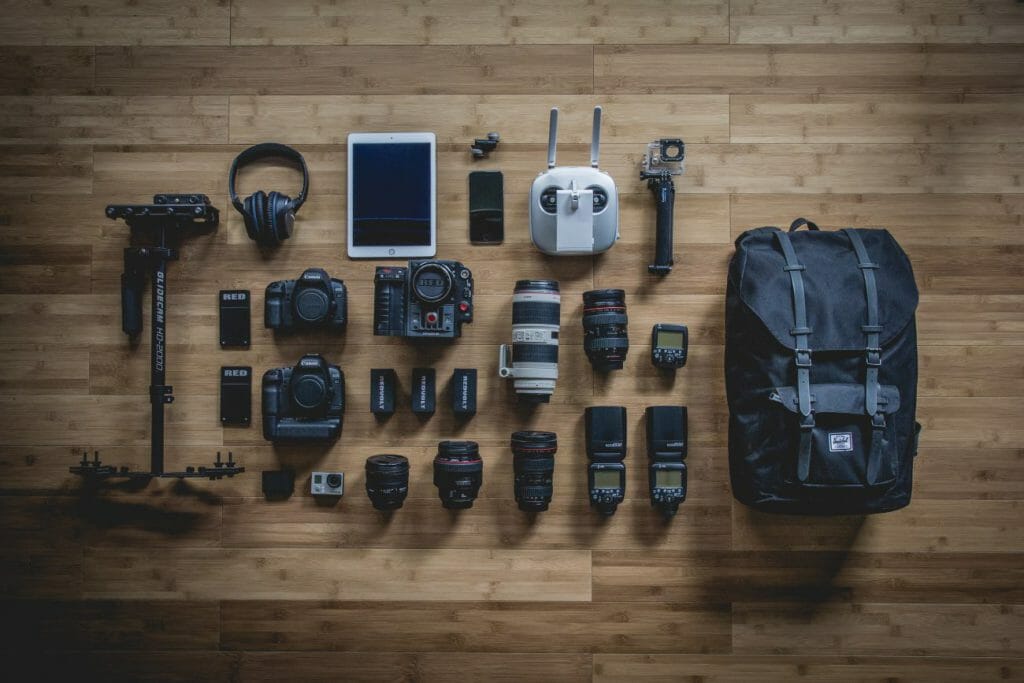
What you’ll often find when shopping for cameras on sites like Amazon or eBay, are package offers that add a set of accessories to the camera body. While they may seem attractive at first glance, the additional gear included is usually not worth the extra price.
In many of these package deals, you’ll find SD cards, cleaning kits, and filters that can seem useful if you are starting out, but are usually not quality products. The best idea is to start with a camera body and a multipurpose zoom lens or two, adding additional gear over time.
How much resolution do I need?
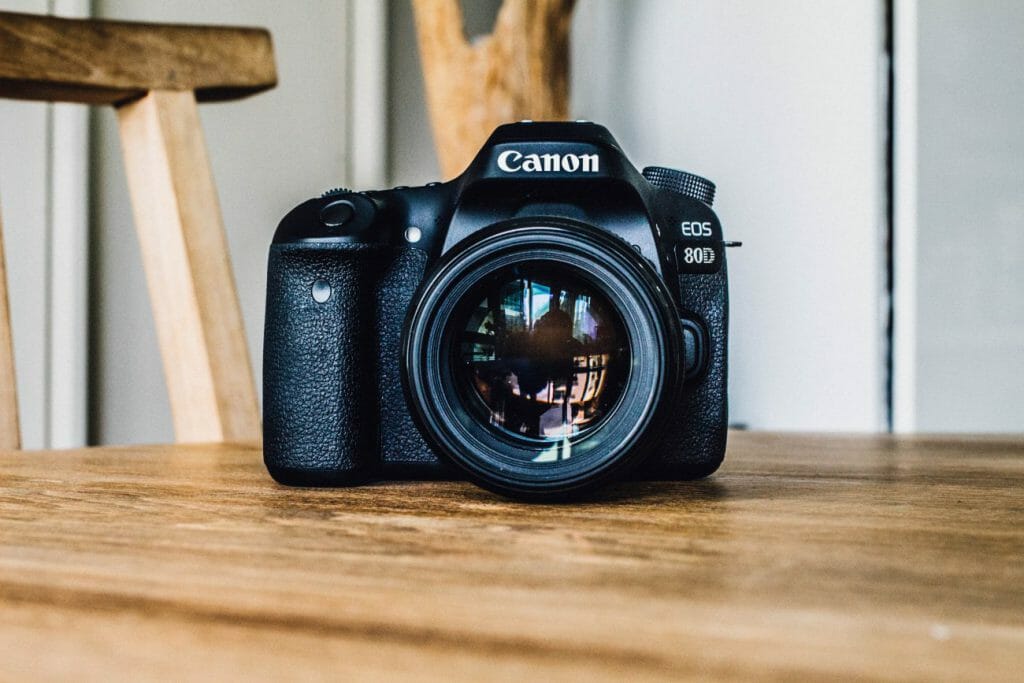
When it comes to resolution, it’s hard to go wrong these days. All modern DSLR cameras offer enough resolution for detail-rich pictures to be captured. High resolution obviously provides some advantages, but anything above 10 megapixels will not be essential to a beginner. Considering that most entry-level DSLRs come with a resolution of about 20 megapixels, you shouldn’t overthink this.
If your goal is to share your pictures digitally, you will be fine with pretty much any camera on this list, unless you need to crop big parts of your photos during the editing stage. If you are planning to print your images in a large format, however, those extra megapixels will come in handy.
What about sensor size?
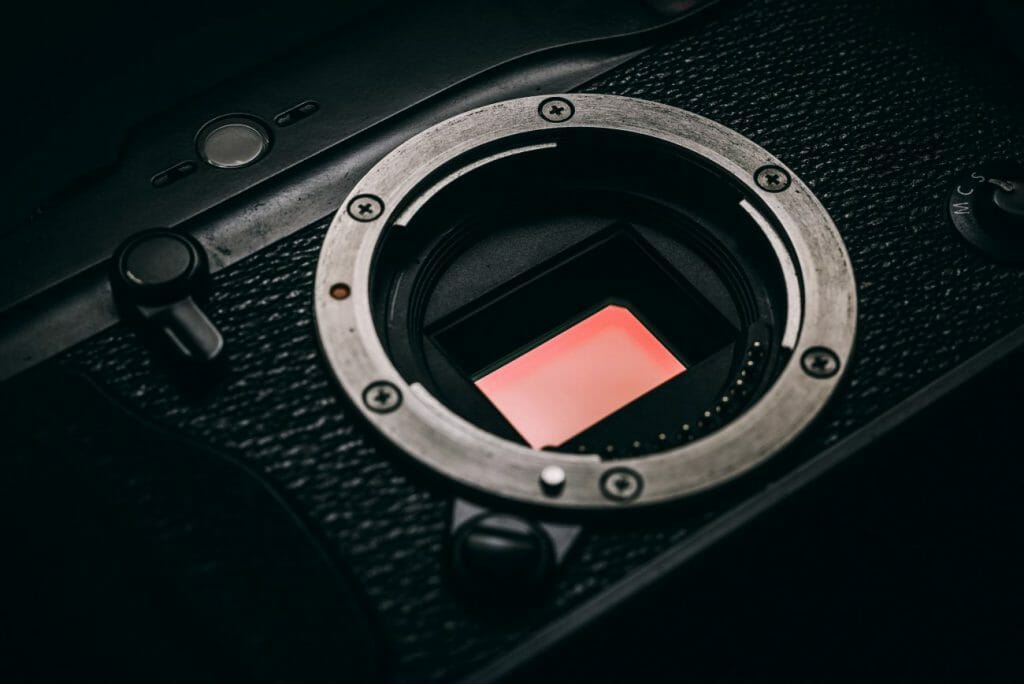
As you’ve probably noticed, all the cameras on this list employ an APS-C sensor. But what does this mean? APS-C sensors have a size of 23.6 x 15.6 millimeters, which is smaller than 36 x 24-millimeter sensors found on professional full-frame cameras. The size of the sensor determines how much light is needed to create an image. Therefore, larger sensors can absorb more light and produce higher quality images. Full-frame sensors offer a much higher resolution, but they obviously come at a price.
A crop sensor is usually more than enough for beginners and hobbyists. There is only one thing you should keep in mind when using a DSLR with an APS-C sensor, the crop factor. Because of the smaller size, an APS-C sensor crops the image by about 1.5 times compared to a full-frame sensor. In simple terms, this means that mounting a 35mm lens on your crop-sensor camera will actually give you a 50mm view. The crop factor of APS-C is something one gets quickly used to and can come in handy when shooting distant subjects with a telephoto lens, as it increases, even more, their focal length.
Should I get the kit lens?
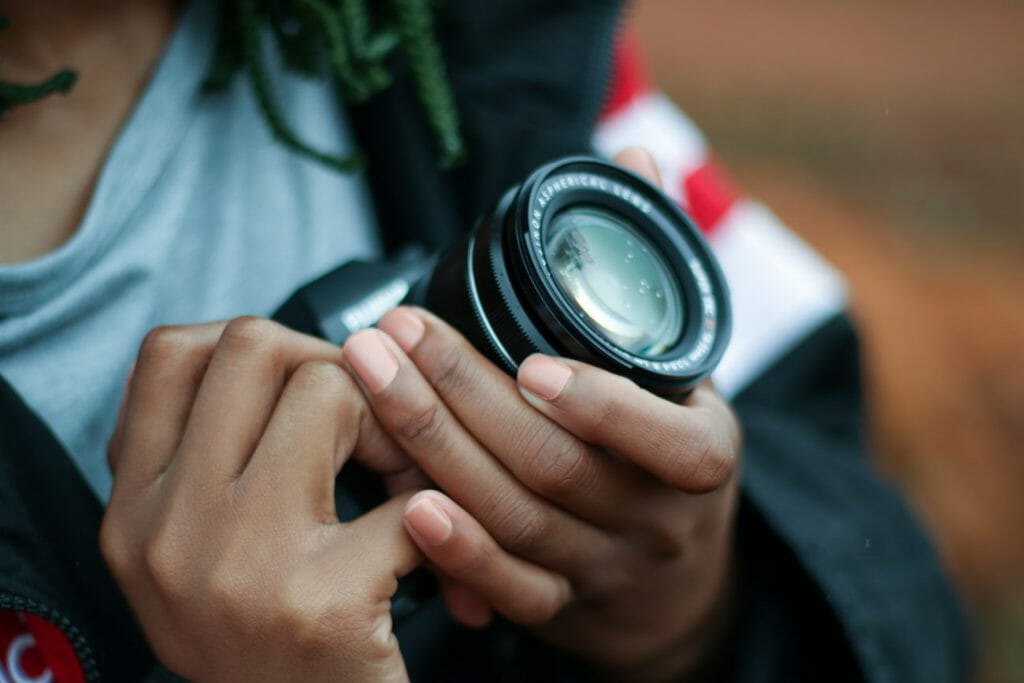
The kit lens that comes with most entry-level DSLR camera bodies is usually a good starting point to learn how to photograph. Kit lenses are not the best in terms of low light performance or build, but they are versatile enough to allow you to experiment with different subjects.
When possible, opt for a kit lens with an integrated image stabilization (IS) system. This feature helps reduce the risk of blur appearing in your images, compensating for the small vibrations that occur when shooting handheld. Kit lenses with IS are usually not much more expensive than non-stabilized lenses, so it’s definitely worth investing in one if the option is available.
If you choose not to get the kit lens, there are many budget options available depending on what type of photography you want to focus on. Fixed lenses like a 50mm f1.8 produce great images (but lack in versatility). Third-party manufacturers such as Sigma or Tamron offer quality gear for a lower price than the original lenses, covering more or less all focal lengths.
Should I buy a DSLR or a mirrorless?
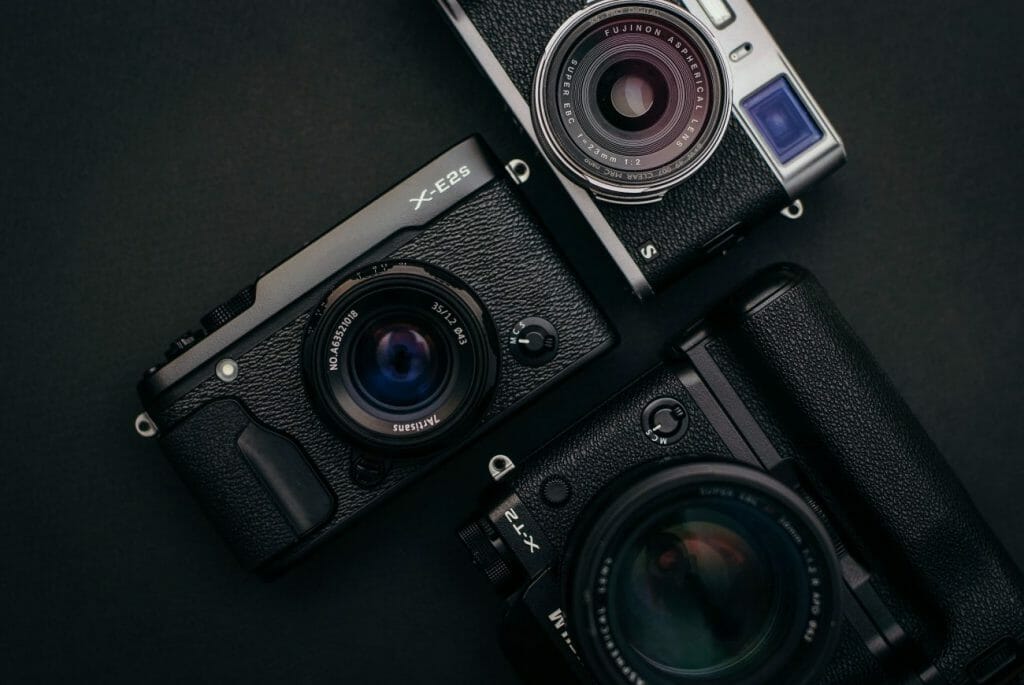
With the growth in popularity of mirrorless cameras, many experts have declared the “death of DSLRs.” While it is true that mirrorless cameras provide similar image quality in a much smaller package, DSLRs are still going strong and are unlikely to disappear anytime soon.
DSLR cameras provide you with a solid and durable piece of equipment. They tend to perform better in low light and have a longer battery life. Brands like Canon and Nikon offer a vast catalog of lenses, in case you decide to upgrade in the future.
Interchangeable lenses

Smartphone and point-and-shoot cameras may have reached impressive results in terms of image quality, but the ability to switch between lenses gives a huge advantage to DSLR cameras.
When you buy a DSLR you are able to specialize in a certain type of photography by mounting lenses designed for that purpose. Big brands have dozens of lenses you can choose from. Whether your focus is architecture, portraits, wildlife or landscapes, there is something there for you.
Lenses are obviously an investment, with some products costing more than the camera itself. However, shooting with the right glass will make an incredible difference. If you want to make your images stand out, consider what lenses you will need to take your photography to the next level.
In conclusion, what entry-level DSLR camera should I buy?
All modern entry-level DSLR cameras provide you with the essential features to shoot great images. Clearly, some models are better than others, but even if you are tight on budget, you can find a camera that will produce excellent results.
While it’s not easy to navigate through brand names, specifications, and features, with this article we hope to have cleared some confusion. Buying the first DSLR is always a big step. By choosing one of the models reviewed above, we are sure you won’t have any regrets.
Curious about lenses, tripods, or backpacks? Make sure you check out our other gear articles for up-to-date information on the best tools of the craft!
